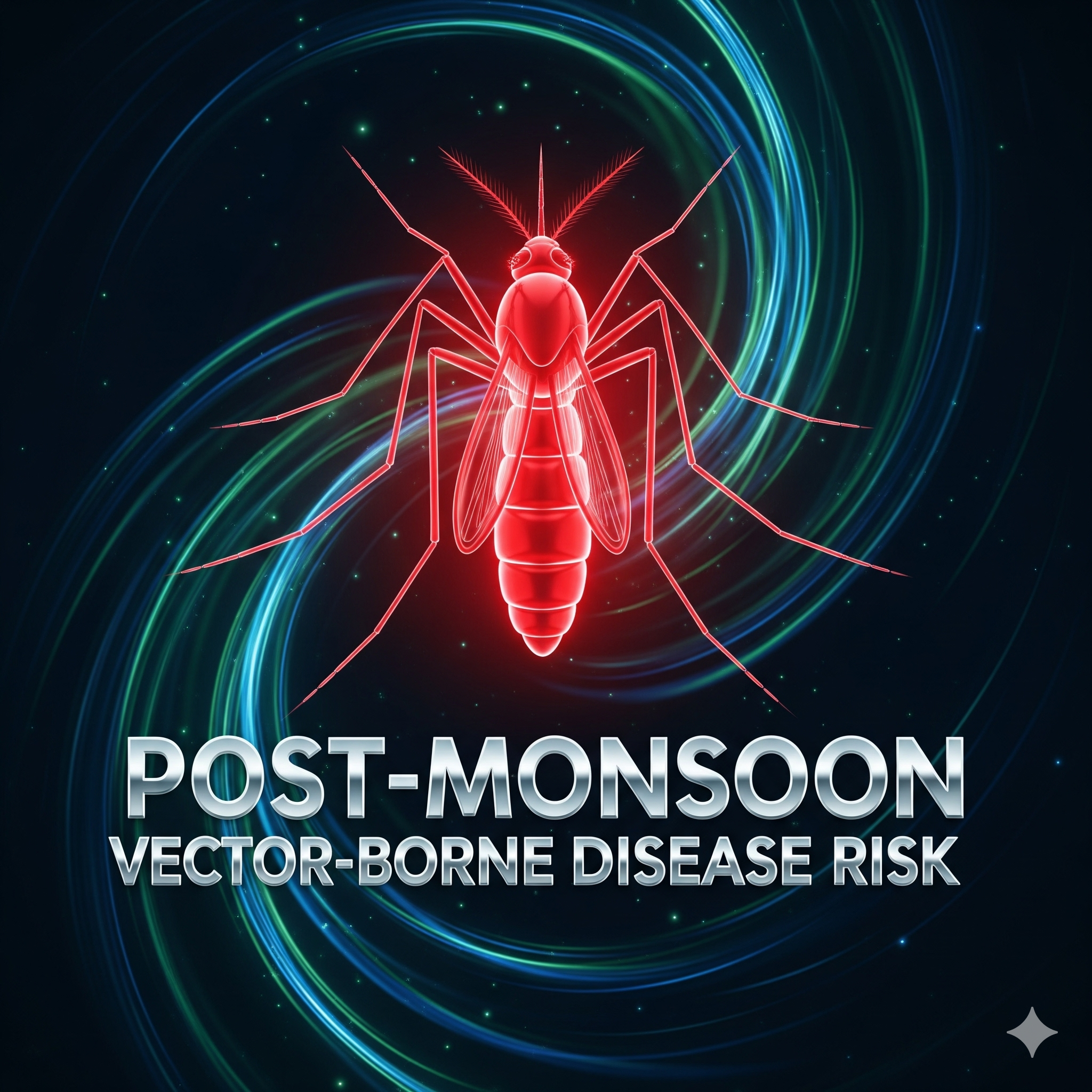Introduction
India’s monsoon season is both a boon and a challenge. While it replenishes water reservoirs, supports agriculture, and sustains ecosystems, it also creates conditions conducive to the proliferation of vector-borne diseases. Diseases such as dengue, malaria, chikungunya, and Japanese encephalitis often spike in the post-monsoon period due to stagnant water, flooding, and increased vector breeding habitats.
The Ministry of Health and Family Welfare (MoHFW) has repeatedly emphasized the need for heightened vigilance post-monsoon. Public health infrastructure, which includes surveillance networks, primary health centers, hospitals, and community outreach programs, faces immense pressure during this period. The convergence of monsoon-related flooding, waterlogging, and increased human-vector contact poses a significant challenge for health administrators and policymakers.
This essay examines the risk of vector-borne diseases in post-monsoon India, explores government measures, evaluates the implications for public health infrastructure, and provides recommendations for future preparedness.
Understanding Vector-Borne Diseases
Vector-borne diseases are illnesses transmitted by vectors such as mosquitoes, ticks, and flies. In India, the most prominent post-monsoon vector-borne diseases include:
1. Dengue
- Caused by the Aedes aegypti mosquito.
- Symptoms: High fever, severe headache, joint and muscle pain, rash, and in severe cases, dengue hemorrhagic fever.
- Seasonal peak: Post-monsoon, especially between September and November.
- Contributing factors: Stagnant water in urban areas, water storage containers, clogged drains, and inadequate sanitation.
2. Malaria
- Caused by Plasmodium parasites transmitted via the Anopheles mosquito.
- Symptoms: Fever, chills, sweating, nausea, fatigue, and in severe cases, cerebral malaria.
- Seasonal peak: Post-monsoon due to breeding in puddles, waterlogged fields, and neglected drainage systems.
3. Chikungunya
- Transmitted by Aedes mosquitoes (same as dengue).
- Symptoms: Fever, severe joint pain, rash, and fatigue.
- Often confused with dengue due to similar symptoms but distinguished by more intense joint pain.
4. Japanese Encephalitis (JE)
- Caused by the JE virus transmitted by Culex mosquitoes.
- Symptoms: Fever, headache, vomiting, neurological complications, and sometimes death.
- Primarily affects rural areas with paddy fields and stagnant water.
5. Other Emerging Vector-Borne Diseases
- Zika virus, West Nile virus, and lymphatic filariasis have also shown localized outbreaks, necessitating surveillance and early warning mechanisms.
Post-Monsoon Risk Factors
Several environmental, socio-economic, and behavioral factors contribute to heightened vector-borne disease risk after the monsoon:
1. Environmental Factors
- Stagnant Water: Flooding and waterlogging provide ideal breeding grounds for mosquitoes.
- Temperature and Humidity: Warm temperatures accelerate mosquito life cycles and virus replication.
- Urban Flooding: Poor drainage in cities increases the density of Aedes mosquitoes.
2. Socio-Economic Factors
- Population Density: Urban slums with poor sanitation face higher transmission rates.
- Housing Conditions: Lack of screens, open water storage, and poor waste management promote vector breeding.
- Access to Healthcare: Limited access delays early diagnosis and treatment.
3. Behavioral Factors
- Inadequate personal protection, such as mosquito nets or repellents.
- Community negligence in cleaning water containers and surroundings.
- Delays in seeking medical attention due to lack of awareness.
Government Response and Health Ministry Directives
India’s Ministry of Health has laid out multi-tiered strategies to mitigate post-monsoon vector-borne disease outbreaks:
1. Early Warning and Surveillance
- Integrated Disease Surveillance Program (IDSP): Monitors fever outbreaks, vector density, and hospitalization trends.
- State health departments are directed to report weekly case numbers to central authorities.
- Real-time data enables targeted interventions in high-risk districts.
2. Vector Control Measures
- Source Reduction: Elimination of stagnant water in urban and rural areas.
- Larvicidal Measures: Use of larvicides and insect growth regulators in drains, ponds, and construction sites.
- Fogging and Spraying: Space spraying of insecticides in high-risk zones to kill adult mosquitoes.
3. Community Mobilization and Awareness
- Awareness campaigns on personal protection and environmental hygiene.
- Engagement of local self-governments, schools, and NGOs in cleaning drives.
- IEC (Information, Education, and Communication) materials distributed through mass media and social platforms.
4. Strengthening Healthcare Infrastructure
- Stockpiling diagnostic kits, medicines (like artemisinin-based combination therapies for malaria), and dengue supportive care resources.
- Ensuring adequate hospital beds and isolation units for severe cases.
- Training healthcare workers for early diagnosis, vector identification, and outbreak management.
5. Vaccination and Prophylaxis
- Deployment of Japanese Encephalitis vaccines in endemic districts.
- Dengue vaccination campaigns in high-burden areas under pilot programs.
- Prophylactic measures for populations at risk, especially children and elderly.
Implications for Public Health Infrastructure
The post-monsoon surge in vector-borne diseases tests the resilience and preparedness of India’s healthcare system:
1. Strain on Hospitals and Clinics
- Sudden rise in cases can overwhelm primary health centers and urban hospitals.
- Shortage of trained doctors, nurses, and laboratory technicians affects service delivery.
2. Supply Chain Challenges
- Increased demand for diagnostic kits, medicines, and insecticides strains logistics.
- Delays in procurement can hinder timely intervention.
3. Laboratory and Diagnostic Capacity
- Rapid identification of dengue, malaria, and chikungunya cases is crucial.
- Limited laboratory networks in rural areas slow down reporting and surveillance.
4. Workforce Limitations
- Frontline health workers like ASHA (Accredited Social Health Activists) are overburdened during outbreaks.
- Continuous training and incentives are necessary to maintain workforce efficiency.
5. Funding and Resource Allocation
- Post-monsoon emergencies often require rapid funding deployment.
- Ensuring state governments receive adequate central support is critical for swift action.
Challenges in Managing Vector-Borne Disease Outbreaks
- Delayed Reporting: Many cases go unreported, leading to underestimation of outbreak severity.
- Resistance to Insecticides: Overuse of certain chemicals has led to vector resistance.
- Climate Change Effects: Irregular monsoons, flooding, and rising temperatures expand vector habitats.
- Urbanization: Rapid urban expansion without adequate drainage and sanitation exacerbates mosquito breeding.
- Public Awareness Gaps: Misconceptions about disease transmission hinder preventive measures.
Best Practices and Lessons Learned
1. Successful State-Level Interventions
- Kerala: Early warning systems, GIS-based mosquito mapping, and community-led vector control.
- Tamil Nadu: Mobile app-based surveillance for dengue and chikungunya cases.
- Delhi: Fogging drives coordinated with municipal authorities to target breeding hotspots.
2. Community Engagement
- Involving local panchayats, schools, and residential associations in awareness campaigns.
- Promoting household-level source reduction measures like covering water containers and removing stagnant water.
3. Inter-Sectoral Collaboration
- Linking health departments with urban planning, water, and sanitation authorities for holistic interventions.
- Ensuring collaboration with meteorological departments for predictive modeling based on rainfall and humidity patterns.
Recommendations for Future Preparedness
- Strengthen Surveillance Networks
- Expand IDSP coverage to rural and remote areas.
- Use predictive analytics to identify high-risk zones based on rainfall and population density.
- Enhance Laboratory Infrastructure
- Establish more diagnostic labs in rural districts.
- Deploy rapid test kits for on-site detection.
- Promote Public Education
- National campaigns emphasizing personal protection, early treatment, and environmental hygiene.
- School-based programs to engage children as awareness ambassadors.
- Climate-Responsive Vector Control
- Design adaptive measures for flood-prone and urban heat-affected areas.
- Research new vector control technologies like Wolbachia-infected mosquitoes and sterile insect techniques.
- Policy Integration
- Integrate vector-borne disease management into urban planning, disaster management, and water management policies.
- Integrate vector-borne disease management into urban planning, disaster management, and water management policies.
- Resource Mobilization
- Ensure timely allocation of funds and emergency resources post-monsoon.
- Strengthen supply chains for medicines, diagnostics, and vector control chemicals.
Conclusion
Post-monsoon India faces a recurrent but predictable challenge: the surge of vector-borne diseases such as dengue, malaria, chikungunya, and Japanese encephalitis. While environmental conditions created by monsoon rains amplify these risks, proactive government interventions, robust public health infrastructure, and community participation can significantly mitigate their impact.
The Ministry of Health and Family Welfare’s directives, including heightened surveillance, vector control, public awareness campaigns, vaccination drives, and strengthening of healthcare infrastructure, are critical to safeguarding public health. However, the challenge extends beyond immediate response—it requires **long-term planning, inter-sectoral coordination, climate-resilient




